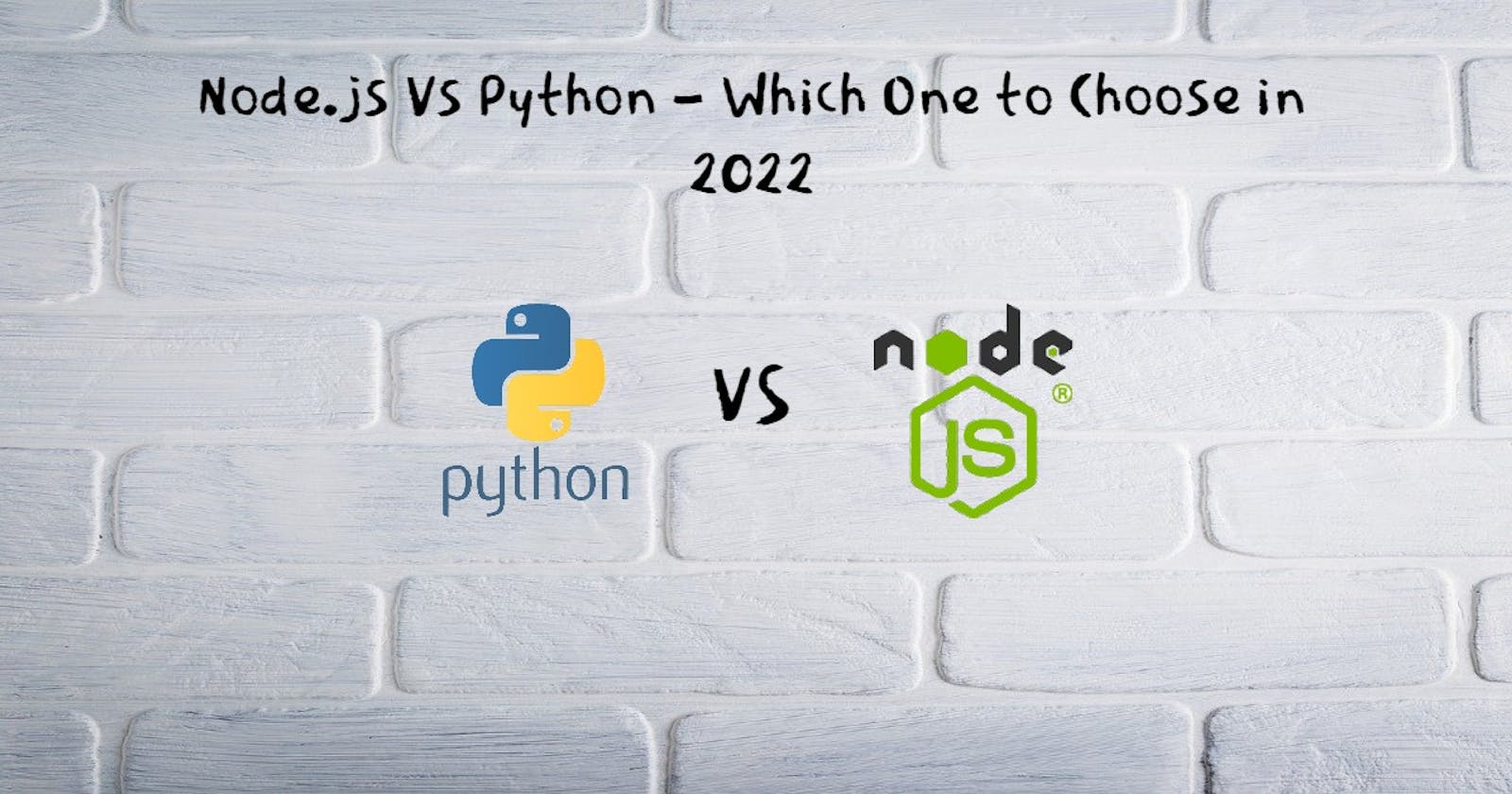Selecting the most appropriate backend technology for your project is essential and challenging for its success. And, when it comes to choosing between Node.js and Python – the two modern, popular backend technologies, it is a tough call.
Both have a huge user community that is constantly expanding. Both have their own set of salient features that are regularly being upgraded and appended. It is a difficult decision for organizations to choose from the two.
Before we go on to compare both the modern technologies, it is vital to understand their basics first.
What is Node.js?
Node.js is an open-source, cross-platform, back-end JavaScript runtime environment that runs on the V8 engine and executes JavaScript code outside a web browser. - Wikipedia
Released in 2009, Node.js is a popular backend technology that is fast, event-driven, and perfect for creating scalable and data-intensive networking apps. It is available on multiple platforms like Linux, Unix, Mac OS X, Windows, etc. It makes use of an event-driven, non-blocking I/O model that is ideal for creating real-time apps. Since it offers great performance and speed, it is considered perfect in creating chat and messaging apps, heavy load apps, and eCommerce portals.
Since applications process the data output in pieces, there is no buffering. Since it is created on Chrome’s V8 JavaScript Engine, it has the fastest code execution library. It has the competence to execute asynchronous code blocks and provides an effective way for importing packages in a project. It has a very fast runtime environment that offers direct access to the file system. There is efficient database support with file management and data processing.
Key Features
- Event driven model
- Real time applications
- Scalable, fast, productive, light weighted
- Multiple libraries, platforms, and packages
- Good community support
- Secure frontend and backend development
- Easy to learn and maintain
- Written in C, C++ making it faster
- Strong networking support
- Full-stack development
- Ideal for microservices development
- Reusable and sharable code
Though Node.js has a plethora of advantages, there are certain associated challenges such as a complicated syntax, slow for huge data volumes, high-end frequency of updates, etc.
Organizations Using Node.js
PayPal, Twitter, Netflix, NASA, LinkedIn, Yahoo, Trello, GoDaddy, eBay, Walmart, Uber, Groupon, medium, Yandex, Amazon Web Services, BBC, Microsoft, etc.
Application Types with Node.js
Data streaming apps, Single Page Apps, data intensive real-time apps, I/O bound apps etc.
What is Python?
Python is a high-level, general-purpose programming language. Its design philosophy emphasizes code readability with the use of significant indentation. - Wikipedia)
Released around 1991, Python is an object-oriented, backend technology that helps developers with its easy writing styles that can be applied to all sizes of projects – big and small. It offers structured programming, useful programming apart from object-oriented programming, with its huge library of open-source tools, testing equipment and web frameworks. Being an interpreted language, it offers stability, reliability, and ease of use. It empowers low-level modules to be included in the interpreter which lets python developers undergo addition/customization of their tools.
Python is considered one of the most modern and fastest technologies as it offers a seamless interface with most commercial databases and languages like C, C++, Java, Active X etc. There are high-level dynamic data types, and it supports dynamic type checking. It has a simple, read-like-English, organized syntax that makes it competent to write complicated logic with less code, which is why it is a developer’s delight. It is used for many applications like web scrapers, proxy servers, game engines, data science related analytical tools etc.
Key Features
- Multi paradigm supporting functional, structured, and object-oriented programming
- Open-source, free, high-level with cross-platform support
- Versatile, easily integrable and extensible
- Multiple modules and packages
- Can be executed on any operating system
- Supports multiple GUI frameworks
- Extensive ecosystem
- Can integrate easily with other languages
- Fast and easy deployment and development
- Strong community support
- Inbuilt AI libraries support
- Access to high-level dynamic data types
Though Python continues to the developer’s choice of preferred backend technologies, there are certain hurdles that it brings along such as threading issues, performance issues on mobile devices, over simplistic etc.
Organizations Using Python
Google, Facebook, Intel, Spotify, Netflix, NASA, Pixar, Dropbox, Quora, Tesla, Apple, Instagram, IBM, JP Morgan Chase, YouTube, Uber, Goldman Sachs etc.
Application Types with Python
Business applications, Desktop GUIs, Web and Internet development, scientific and numeric apps, educational apps etc.
Comparing the Two Technology Stalwarts
The Similarities
- Universal multi-purpose backend technologies
- Huge community support and developer base
- Extensibility and efficacy
- Multiple libraries, development tools, and frameworks to choose from
- Excellent error handling competencies
- Open source and free to use
- Platform agnostic
The Differences
- Overview
Node.js - Event driven, non-blocking I/O mechanism, based on Chrome’s JavaScript engine. Cross platform, JavaScript runtime environment that executes JS code side by side.
Python - Data analysis tool with web framework and testing library and a huge ecosystem. Multi-paradigm, general-purpose, interpreted, high-level language.
- Released In
Node.js - Released in 2009
Python - Released in 1991
- Performance and Speed
Node.js - Fast processing, huge storage, can process many requests simultaneously. Transfers in bulk.
Python - Comparatively slower in processing requests, has a large storage capacity. Has a single code flow.
- Package Manager
Node.js - Supports NPM package manager, one of the world’s largest packager repositories
Python - Supports PIP (Pip Installs Package) package manager.
- Learning Curve
Node.js - If you know JavaScript, the learning curve is less. Fundamentals are based on JS and hence easy to grasp.
Python - Simple and easy to understand learning process. Need for fewer lines of code hence easy for developers.
- Architecture
Node.js - Through parallel process execution functionality
Python - Through its simplified syntax and non-concurrent process
- Interpreter
Node.js - JavaScript interpreter is utilized by Node.js.
Python - CPython interpreter is used by Python.
- Best Suited For
Node.js - For simple apps that need little programming for more functionalities, online apps, website development, real-time chat apps, SPA, collaboration apps.
Python - For memory dependent, bigger tasks that involve complex functionalities, numerical computations, machine learning, face recognition apps, image processing software.
- Support for
Node.js - Support for Callbacks, through which programming is done.
Python - Support for Generators, which makes it easy to program.
- Popular Frameworks
Node.js - Express.js, Koa.js, Nest.js, Meteor.js, Feather.js, Socket.io, Total.js etc.
Python - CherryPy, Bottle, CubicWeb, Dash, Django, Falcon, Flask, Giotto etc.
When to Use What?
Use Node.js when
- There is a need to create frontend and backend with a single stack
- There is performance rich, faster progress needed with limited resources
- Real-time web projects are to be created like trackers, chats, messaging systems etc.
- Data intensive real-time apps need to be created
- There are heavy load applications and eCommerce portals being developed
Use Python when
- There is AI related development, automation, big data, backend development
- There is involvement of scientific computing and data analytics
- Projects are complex with huge amount of data and calculations
- There is a need for a large ecosystem including data analytics tools, testing tools etc.
- Ease of use, faster learning and consistency are of most importance
The Debate Goes On…
The ever-burning question still lingers on – which one to choose out of Node.js and Python! They both have their set of salient features and advantages to showcasing with several well-renowned organizations to their credit, as mentioned in detail in the above sections. And the list seems to go on and on. At the same time, they do have trouble areas that cannot be avoided.
Finally, it is up to the organizations to decide which one to finalize, based on different parameters like speed, libraries, architecture, extensibility, syntax, skills of the development team, budget, location, scalability, type, and purpose of the project. Both are considered the best in the arena of backend technologies and hence whichever you choose, is like the better out of the best!

